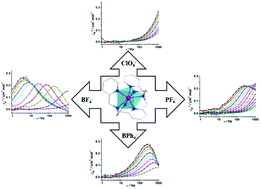Structure, magnetic anisotropy and relaxation behavior of seven-coordinate Co(ii) single-ion magnets perturbed by counter-anions†
Abstract
A series of mononuclear seven-coordinate Co(II) complexes [CoII(BPA-TPA)](ClO4)2·H2O (2-ClO4), [CoII(BPA-TPA)](PF6)2 (3-PF6) and [CoII(BPA-TPA)](BPh4)2 (4-BPh4) have been synthesized based on the ligand 2,6-bis(bis(2-pyridylmethyl)amino)methylpyridine (BPA-TPA), and their structures have been characterized by single-crystal X-ray diffraction. All these complexes feature an intermediate coordination polyhedron between a capped trigonal prism and a capped octahedron, which is perturbed by the variation of the counter anions. Easy-plane magnetic anisotropies for all complexes were revealed via the analyses of the direct-current magnetic data and high-field electron paramagnetic resonance (HFEPR) spectra. They show slow magnetic relaxation under applied direct current field, which is similar to the previously reported complex [CoII(BPA-TPA)](BF4)2 (1-BF4) with a capped trigonal prism. This work provides a new example of modulating the properties of single-ion magnets (SIMs) by changing the counter anions.



 Please wait while we load your content...
Please wait while we load your content...